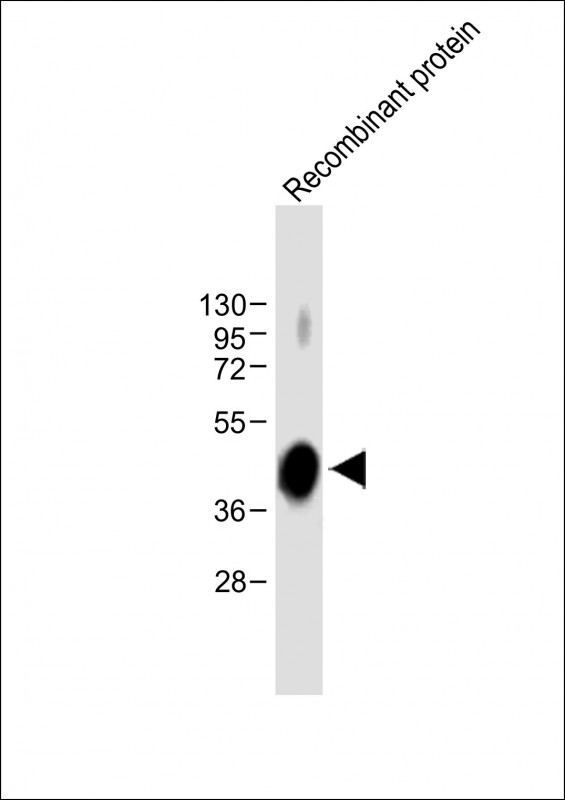ADAMTS4 Antibody
Purified Mouse Monoclonal Antibody (Mab)
- SPECIFICATION
- CITATIONS
- PROTOCOLS
- BACKGROUND

Application
| WB, E |
|---|---|
| Primary Accession | O75173 |
| Reactivity | Human |
| Predicted | Human |
| Host | Mouse |
| Clonality | monoclonal |
| Isotype | IgG1,κ |
| Clone/Animal Names | 1995CT113.89.78 |
| Calculated MW | 90197 Da |
| Gene ID | 9507 |
|---|---|
| Other Names | A disintegrin and metalloproteinase with thrombospondin motifs 4, ADAM-TS 4, ADAM-TS4, ADAMTS-4, 3.4.24.82, ADMP-1, Aggrecanase-1, ADAMTS4, KIAA0688 |
| Target/Specificity | This ADAMTS4 antibody is generated from a mouse immunized with a recombinant protein from the human region of human ADAMTS4. |
| Dilution | WB~~1:8000 E~~Use at an assay dependent concentration. |
| Format | Purified monoclonal antibody supplied in PBS with 0.09% (W/V) sodium azide. This antibody is purified through a protein G column, followed by dialysis against PBS. |
| Storage | Maintain refrigerated at 2-8°C for up to 2 weeks. For long term storage store at -20°C in small aliquots to prevent freeze-thaw cycles. |
| Precautions | ADAMTS4 Antibody is for research use only and not for use in diagnostic or therapeutic procedures. |
| Name | ADAMTS4 |
|---|---|
| Synonyms | KIAA0688 |
| Function | Cleaves aggrecan, a cartilage proteoglycan, at the '392- Glu-|-Ala-393' site and may be involved in its turnover (PubMed:10356395, PubMed:10827174). Also cleaves COMP (PubMed:39672391). May play an important role in the destruction of aggrecan in arthritic diseases. Could be a critical factor in the exacerbation of neurodegeneration in Alzheimer disease. |
| Cellular Location | Secreted, extracellular space, extracellular matrix |
| Tissue Location | Expressed in brain, lung and heart (PubMed:23897278). Expressed at very low level in placenta and skeletal muscles (PubMed:23897278). Isoform 2: Detected in osteoarthritic synovium (PubMed:16723216, PubMed:23897278) |

Thousands of laboratories across the world have published research that depended on the performance of antibodies from Abcepta to advance their research. Check out links to articles that cite our products in major peer-reviewed journals, organized by research category.
info@abcepta.com, and receive a free "I Love Antibodies" mug.
Provided below are standard protocols that you may find useful for product applications.
Background
Cleaves aggrecan, a cartilage proteoglycan, and may be involved in its turnover. May play an important role in the destruction of aggrecan in arthritic diseases. Could also be a critical factor in the exacerbation of neurodegeneration in Alzheimer disease. Cleaves aggrecan at the '392-Glu-|-Ala-393' site.
References
Tortorella M.D.,et al.Science 284:1664-1666(1999).
Wainwright S.D.,et al.Matrix Biol. 25:317-320(2006).
Sawaji Y.,et al.Submitted (JUL-2001) to the EMBL/GenBank/DDBJ databases.
Ishikawa K.,et al.DNA Res. 5:169-176(1998).
Clark H.F.,et al.Genome Res. 13:2265-2270(2003).
If you have used an Abcepta product and would like to share how it has performed, please click on the "Submit Review" button and provide the requested information. Our staff will examine and post your review and contact you if needed.
If you have any additional inquiries please email technical services at tech@abcepta.com.













 Foundational characteristics of cancer include proliferation, angiogenesis, migration, evasion of apoptosis, and cellular immortality. Find key markers for these cellular processes and antibodies to detect them.
Foundational characteristics of cancer include proliferation, angiogenesis, migration, evasion of apoptosis, and cellular immortality. Find key markers for these cellular processes and antibodies to detect them. The SUMOplot™ Analysis Program predicts and scores sumoylation sites in your protein. SUMOylation is a post-translational modification involved in various cellular processes, such as nuclear-cytosolic transport, transcriptional regulation, apoptosis, protein stability, response to stress, and progression through the cell cycle.
The SUMOplot™ Analysis Program predicts and scores sumoylation sites in your protein. SUMOylation is a post-translational modification involved in various cellular processes, such as nuclear-cytosolic transport, transcriptional regulation, apoptosis, protein stability, response to stress, and progression through the cell cycle. The Autophagy Receptor Motif Plotter predicts and scores autophagy receptor binding sites in your protein. Identifying proteins connected to this pathway is critical to understanding the role of autophagy in physiological as well as pathological processes such as development, differentiation, neurodegenerative diseases, stress, infection, and cancer.
The Autophagy Receptor Motif Plotter predicts and scores autophagy receptor binding sites in your protein. Identifying proteins connected to this pathway is critical to understanding the role of autophagy in physiological as well as pathological processes such as development, differentiation, neurodegenerative diseases, stress, infection, and cancer.


